Bigfoot’s Killer-N 1102 Wireless Networking vs. the World
by Jarred Walton on August 10, 2011 10:38 AM ESTNetgear 2.4GHz Obstructed Performance
Our next test is the same router as before, only now we’ve moved the laptops to the opposite side of the house. For this test, the router is still upstairs, but the laptops are about 50 feet away (direct line) with several walls and a floor in between. As you might expect, performance is lower on every laptop in every test, though some controllers hold up better than others.
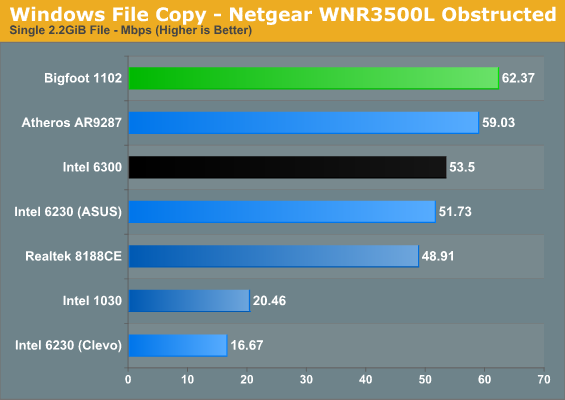
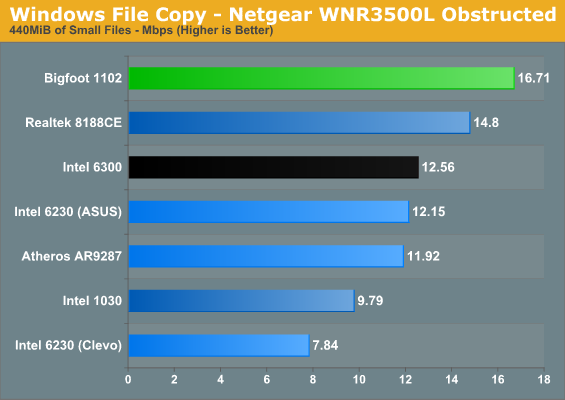
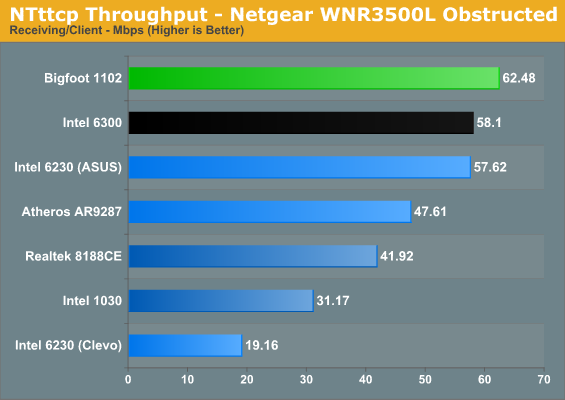
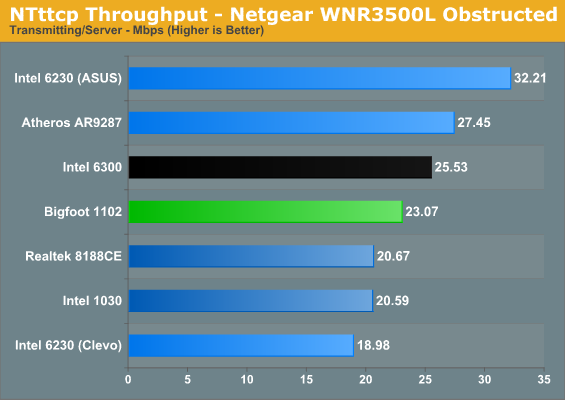
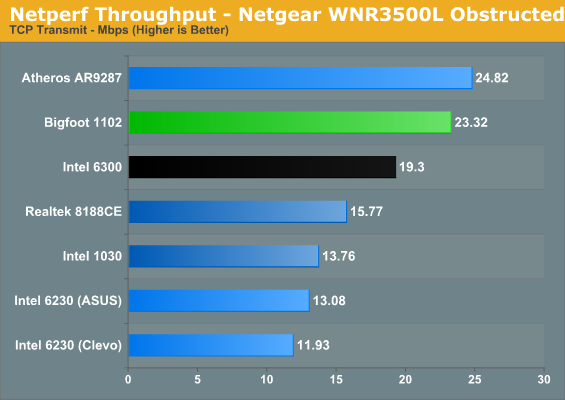
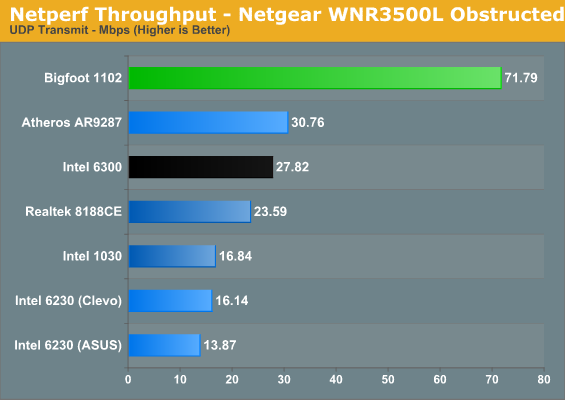
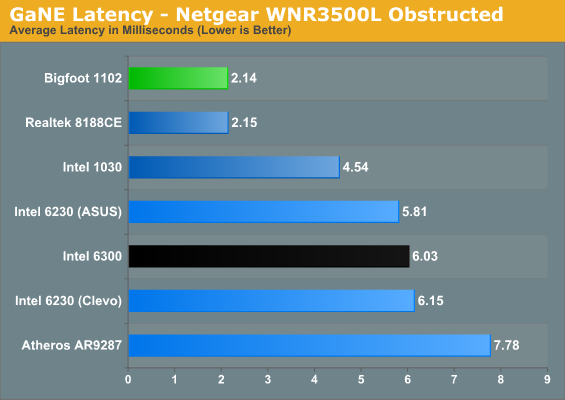
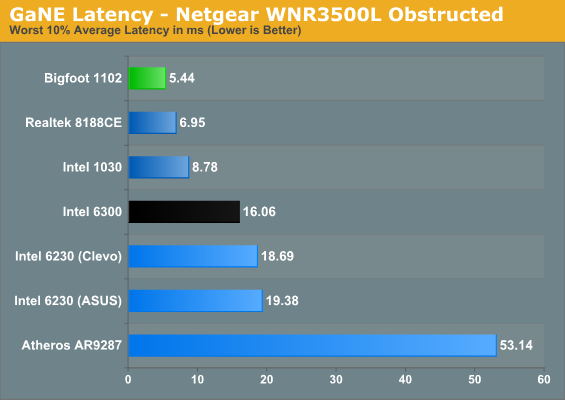
The Bigfoot 1102 leads in most of the tests, with the Realtek and Atheros generally claiming second and third. Once again, the ASUS K53E performs better than the Clevo sample unit in this test—much better in fact—despite both using the same Intel Advanced-N 6230 chipset. Also note that all of the cards do quite a bit better at receiving data than at transmitting (see the NTttcp charts), which makes sense as most laptops don’t put a ton of power into their transmit radios. It’s interesting that in our obstructed tests, the Intel 6230 (in the K53E) and 6300 along with the Atheros AR9287 all manage higher transmit rates than the BF 1102 with NTttcp, though that advantage doesn’t translate over to Netperf.
The Bigfoot 1102 still maintains a decisive lead in the latency tests, with the Realtek 8188CE nipping at its heels. Oddly enough, latency is actually lower on a couple of the cards (the K53E with Intel 6230 specifically), but that’s probably in part because the connection rate is no longer as high. Most of the laptops connected at less than 130Mbps, with a lot of variance in the speed as the cards frequently renegotiate their connections. Bigfoot also continues to dominate the copy time for lots of small files, again illustrating that their “secret low latency sauce” helps in areas other than gaming. The single stream Realtek chipset comes in second in that test, and it has the second lowest latency of the tested controllers.
The takeaway here is that even the best network cards won’t perform all that well without a clear signal. If you have a large house or office and you want to provide good coverage, setting up multiple access points would be necessary to obtain optimal performance for every room. We’ll look at how far the laptops can get from the router before experiencing connection problems later, but in most houses the Bigfoot 1102 should get a good signal.










52 Comments
View All Comments
DesktopMan - Wednesday, August 10, 2011 - link
What's the reason for the big difference with these results: http://www.smallnetbuilder.com/wireless/wireless-r...Anyone know?
Reflex - Wednesday, August 10, 2011 - link
Probably different laptops. This review is unfortunatly not very good because if I'm reading the first couple pages correctly, he used different laptops for each card. Contrary to his earlier experience, most laptops will accept any wifi card you wish. I swapped in a 6300 in my Dell a year ago and it works great.They need to establish a baseline testing platform to isolate the perf between the cards. Testing them all on different laptops invalidates the test. Hard drives, CPU's, memory speed, etc can have a *huge* impact on wifi performance, especially for file copy type operations. And the range test is completely irrelevant as everyone has their own way of routing the antennas up through the lid.
JarredWalton - Wednesday, August 10, 2011 - link
For wireless, the storage actually matters almost not at all. I swapped in an HDD to one of the laptops and ran the two file copy tests. The HDD was withing 1 second of the SSD for the large file, and within 3 seconds on the small files. On GbE, HDD vs. SSD is a huge disparity, but with WiFi topping out at <30MBps it really doesn't matter much. The WiFi latency appears to be almost as bad as the HDD latency for seek operations.But you're right: the different laptops all make it hard to to apples-to-apples, and depending on vendor swapping in a different WiFi card may or may not work. The real issue for me was lack of time; I kept going back and forth between devices as I discovered a potential issue with one of the results. Now that I'm more comfortable with what WiFi testing entails, I'm hoping (not right now, but maybe in a couple months) to go through and test a bunch of cards in a single laptop, as well as in a PCI-E x1 desktop adapter.
endrebjorsvik - Sunday, August 14, 2011 - link
This puzzles me as well. The last couple of days I have been struggling with getting decent performance from my own setup. I have a Netgear WNDR3700v2 and a Lenovo X220 fitted with i5-2520M and Intel 6300 3x3 and running W7. A HP ProLiant ML110 G6 with GbE and 4x2TB RAID-Z is serving the test-files.According to smallnetbuilder.com, the WNDR3700v2 ( http://www.smallnetbuilder.com/wireless/wireless-r... ) should be faster than WNR3500L ( http://www.smallnetbuilder.com/wireless/wireless-r... ), so my setup should at least be as fast as Jarred's Netgear-Intel6300-Ideal-result (154 Mb/s).
I have tried both 2,4 and 5 GHz with both 20 and 40 MHz BW and with both stock and open firmware (dd-wrt), but I don't even get to 90 Mb/s (Windows file transfer tops out at 11 MB/s = 88 Mb/s, and usually stays below 10 MB/s). The distance between the router and laptop is ~6 feet, and I have tried every possible position of the router (different antenna directions). The laptop lid is open (~90 degrees).
So I wonder if you (Jarred) came across any mindblowing tricks that increased the throughput dramatically? Or was the Netgear-Intel6300-combo just plug'n'play?
JarredWalton - Sunday, August 21, 2011 - link
What are you copying from? 11MB/s max sounds like you've got the Ethernet side hooked up to a 100Mb port, or else you're doing a transfer from one wireless PC to another? In that case, you'd be doing 22MB/s of wireless traffic, which would be pretty good considering collisions and such.ss284 - Wednesday, August 10, 2011 - link
It would have been really great if a recent macbook's wireless throughput was tested. I believe all the recent refreshes have the same broadcom based wireless adapter.xdrol - Wednesday, August 10, 2011 - link
"the number of streams cannot be more than the larger of the transmit/receive chains (so 2x2:3 isn’t possible, but 2x3:3 is)"No it is not. It cannot be more than the SMALLER of the two. But the transmit and receive antennas are on a different device, so a given device could support more than it's Tx/Rx antennas, but only in the other direction (where it does have more antennas).
As for specifying what 1 given device can do, then there are actually 4 different numbers, 3 are not enough:
- The number of Tx antennas (a)
- The number of spatial streams to be received (<=a)
- The number of Rx antennas (b)
- The number of spatial streams to be transmitted (<=b)
As WiFi is a symmetrical system, the Tx and Rx features of a device are usually the same (read: I'm yet to see any that differ) - unlike e.g. LTE, where the usual MIMO currently is only downlink, but not uplink (it has different PHY for uplink anyway).
In the example, the 2x3:3 is valid only if you meant it has 2 Tx antennas, 3 Rx antennas, and it can RECEIVE 3 spatial streams. As it has only 2 antennas, the maximum outbound spatial streams is 2.
Brian Klug - Wednesday, August 10, 2011 - link
That's technically right, and we do mention that the Intel 1030 can do two streams on Rx and one on Tx, but I've seen very few routers actually support an asymmetrical MIMO scheme like that. Even the intel card for example always only shows 1 stream being used for Tx and Rx, so in practice really it should be symmetrical.-Brian
James5mith - Wednesday, August 10, 2011 - link
Maybe I'm used to living in smaller places, but 60 feet from your front door to the router? That seems a bit extreme. Is the router in the attic, and the front door in the basement corner of the house or something?James5mith - Wednesday, August 10, 2011 - link
Actually, more to the point, if it's 60 ft to your front door, then your google maps view shows the Intel 6300 making it nearly 500 ft from the router in the Cisco 2.4GHz test. You stated it was 200 ft.